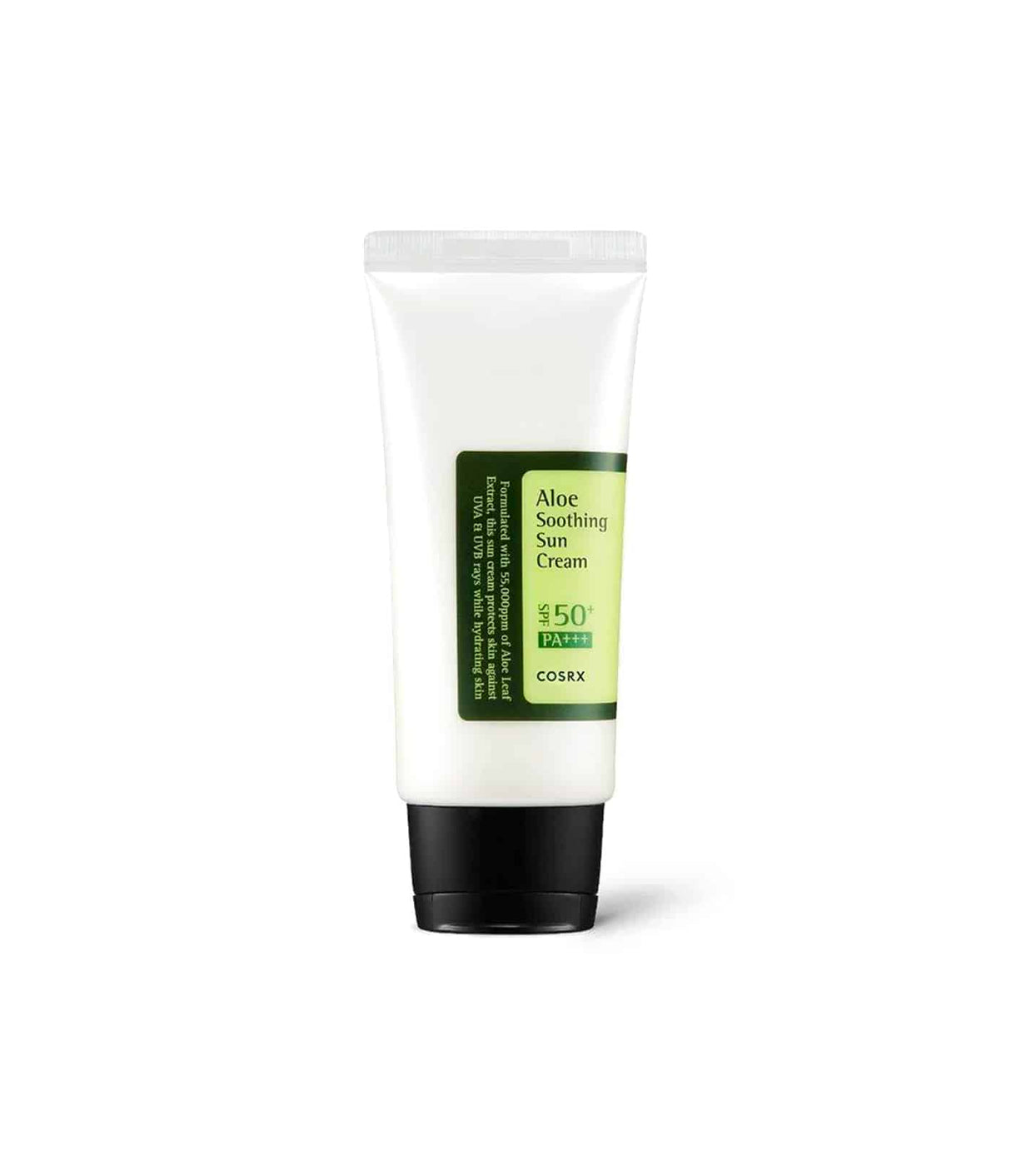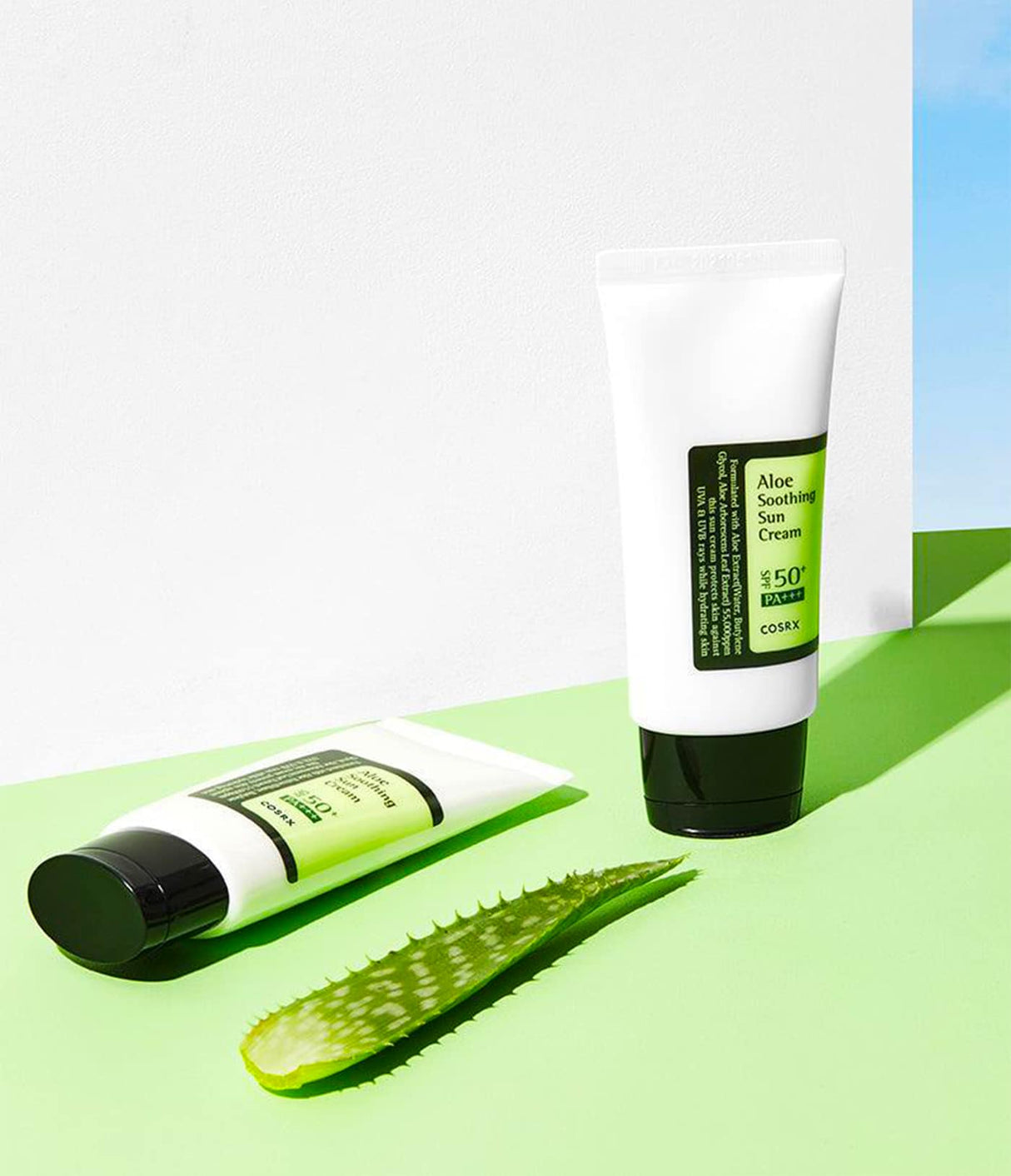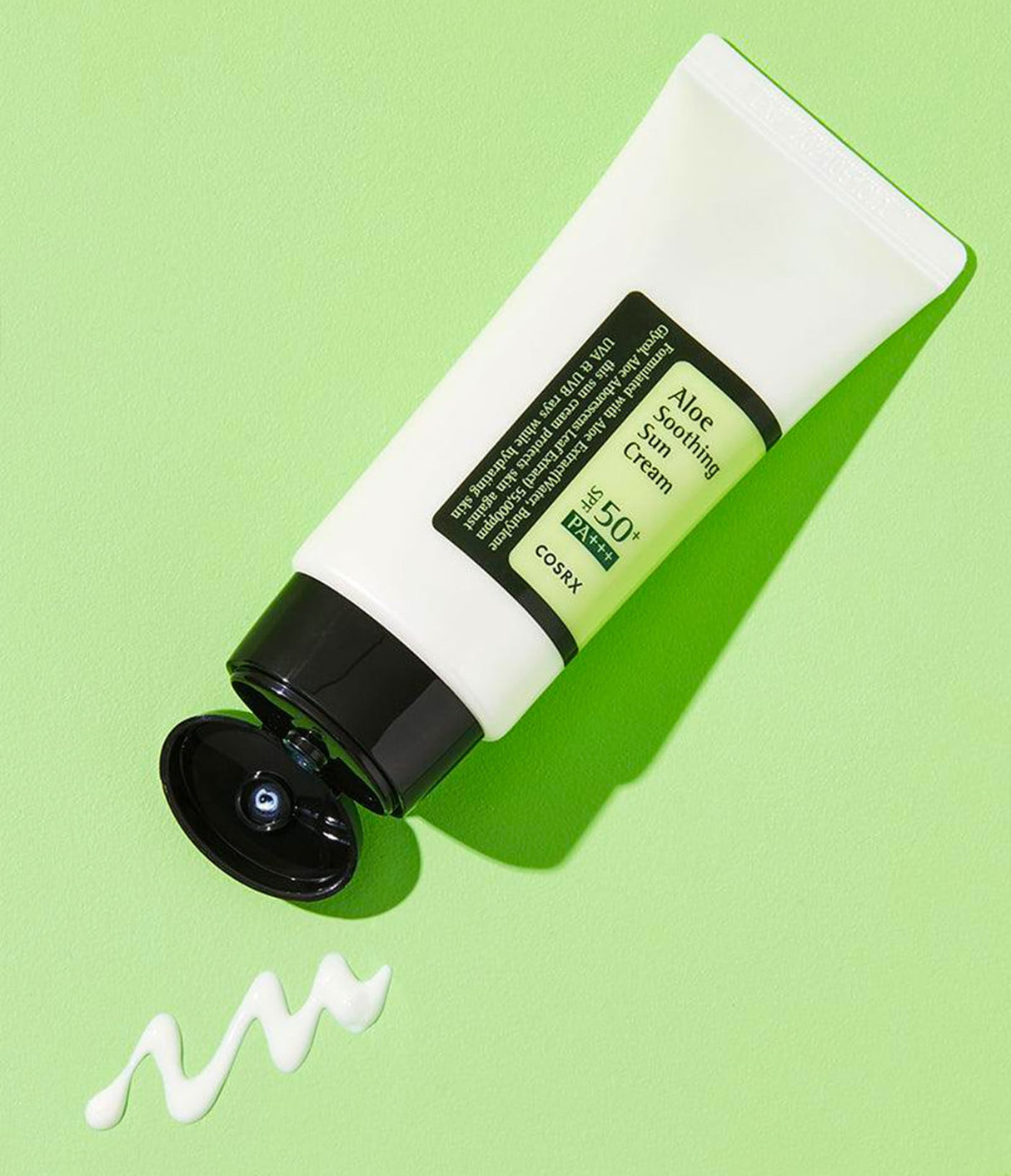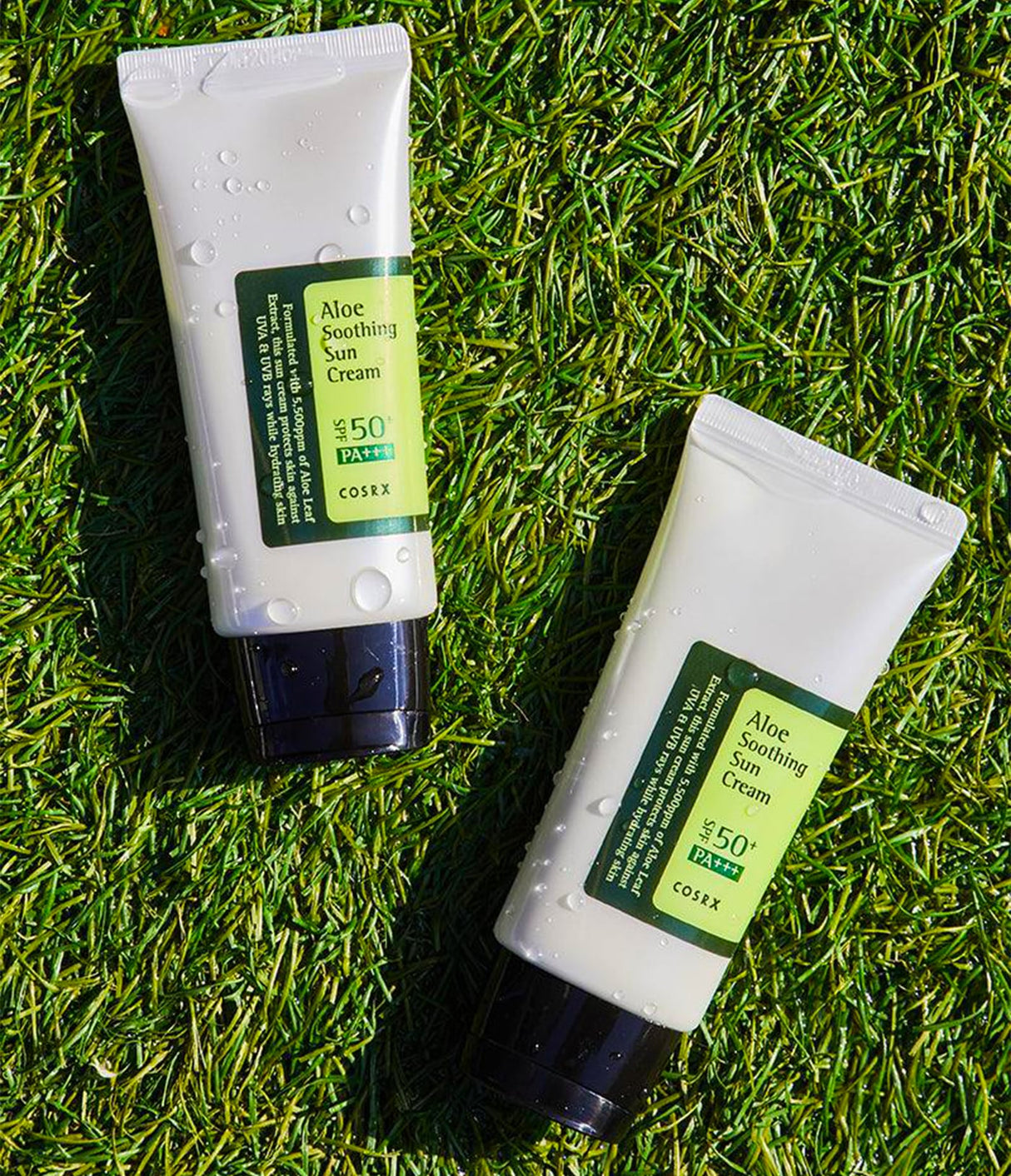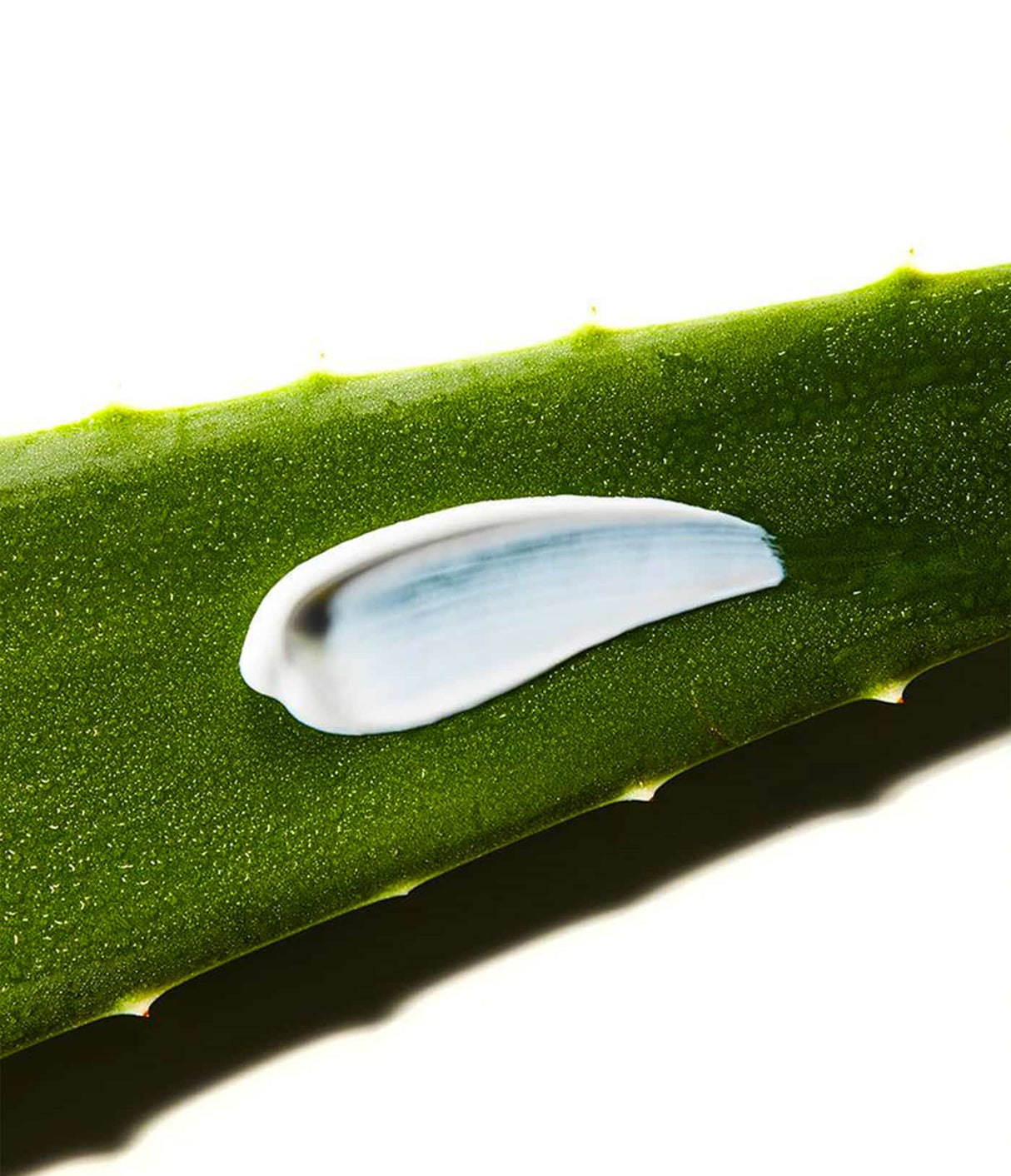Aloe Soothing Sun Cream SPF 50+
Formulated with Aloe Arborescens leaf extract. This daily soothing sunscreen is so light it feels like a moisturizing lotion, without leaving any whitish finish. You can take this daily protector anywhere so you can reapply it at any time.
Aloe Soothing Sun Cream SPF 50+ is backordered and will ship as soon as it is back in stock.
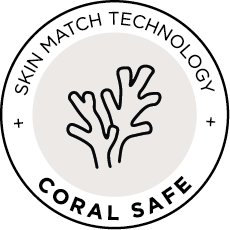
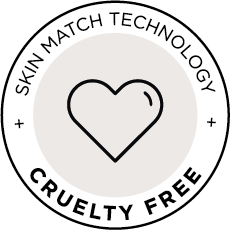
- Nut-Free
- Ammonia-Free
Couldn't load pickup availability
INCI
INCI
WATER
All information below describes only this specific ingredient and its possible effects, utilities and sources. Usage and effect of the ingredient may differ per formulation of each product.
- Sourced from a naturally occuring source
- Can have the following uses in cosmetics: Antiplaque, Skin Conditioning, Solvent
- Can have a moisturizing/hydrating effect on your skin.
- Can have a softening effect.
- Can have a soothing effect.
ETHYLHEXYL METHOXYCINNAMATE
All information below describes only this specific ingredient and its possible effects, utilities and sources. Usage and effect of the ingredient may differ per formulation of each product.
- Synthetically created
- Can have the following uses in cosmetics: UV Absorber, UV Filter
- Can cause allergic reactions.
- Provides either broad-spectrum sun protection from UVA, UVB or ultraviolet radiation.
GLYCERIN
All information below describes only this specific ingredient and its possible effects, utilities and sources. Usage and effect of the ingredient may differ per formulation of each product.
- Can have different sources. (Animal derivative, Synthetic, Botanical, Palm oil)
- Can have the following uses in cosmetics: Denaturant, Hair Conditioning, Humectant, Oral Care, Perfuming, Skin Conditioning, Skin Protecting, Solvent, Viscosity Controlling
- Can be used as a perfuming ingredient.
- Can have a moisturizing/hydrating effect on your skin.
- Can have a softening effect.
- Can have a soothing effect.
PROPYLENE GLYCOL
All information below describes only this specific ingredient and its possible effects, utilities and sources. Usage and effect of the ingredient may differ per formulation of each product.
- Synthetically created
- Can have the following uses in cosmetics: Humectant, Skin Conditioning, Solvent, Viscosity Controlling
- Can cause reactions to sensitive skin.
- Can have a moisturizing/hydrating effect on your skin.
- Can have a softening effect.
- Can have a soothing effect.
CYCLOPENTASILOXANE
All information below describes only this specific ingredient and its possible effects, utilities and sources. Usage and effect of the ingredient may differ per formulation of each product.
- Synthetically created
- Can have the following uses in cosmetics: Emollient, Hair Conditioning, Skin Conditioning, Solvent
- Helps soften and moisturize the skin and can decrease itching and flaking.
- Can have a moisturizing/hydrating effect on your skin.
- Can have a softening effect.
- Can have a soothing effect.
- Is a silicone, which are used for texture, shine and hold.
- Is a siloxane, a class of liquid silicones.
PHENYLBENZIMIDAZOLE SULFONIC ACID
All information below describes only this specific ingredient and its possible effects, utilities and sources. Usage and effect of the ingredient may differ per formulation of each product.
- Synthetically created
- Can have the following uses in cosmetics: UV Absorber, UV Filter
- Provides either broad-spectrum sun protection from UVA, UVB or ultraviolet radiation.
BIS-ETHYLHEXYLOXYPHENOL METHOXYPHENYL TRIAZINE
All information below describes only this specific ingredient and its possible effects, utilities and sources. Usage and effect of the ingredient may differ per formulation of each product.
- Synthetically created
- Can have the following uses in cosmetics: Skin Conditioning, UV Absorber, UV Filter
- Provides either broad-spectrum sun protection from UVA, UVB or ultraviolet radiation.
- Can have a moisturizing/hydrating effect on your skin.
- Can have a softening effect.
- Can have a soothing effect.
DICAPRYLYL CARBONATE
All information below describes only this specific ingredient and its possible effects, utilities and sources. Usage and effect of the ingredient may differ per formulation of each product.
- Can have different sources. (Synthetic, Botanical)
- Can have the following uses in cosmetics: Emollient, Skin Conditioning
- Helps soften and moisturize the skin and can decrease itching and flaking.
- Can have a moisturizing/hydrating effect on your skin.
- Can have a softening effect.
- Can have a soothing effect.
ISOAMYL P-METHOXYCINNAMATE
All information below describes only this specific ingredient and its possible effects, utilities and sources. Usage and effect of the ingredient may differ per formulation of each product.
- Can have the following uses in cosmetics: UV Absorber, UV Filter
POTASSIUM CETYL PHOSPHATE
All information below describes only this specific ingredient and its possible effects, utilities and sources. Usage and effect of the ingredient may differ per formulation of each product.
- Can have different sources. (Synthetic, Botanical)
- Can have the following uses in cosmetics: Emulsifying, Surfactant
- Used as an emulsifier to homogeneously mix ingredients.
- A wash-active substances that is of great importance for cleaning the skin and hair.
ALCOHOL
All information below describes only this specific ingredient and its possible effects, utilities and sources. Usage and effect of the ingredient may differ per formulation of each product.
- Can have different sources. (Synthetic, Botanical)
- Can have the following uses in cosmetics: Antifoaming, Antimicrobial, Astringent, Masking, Solvent, Viscosity Controlling
- Can cause reactions to sensitive skin.
- Works as an antiseptic.
- Not recommended for dry skin, scalp or nails.
- Is a type of alcohol, which can be used to deliver other ingredients into the skin, dissolve oils and temporarily tighten pores.
DIMETHICONE
All information below describes only this specific ingredient and its possible effects, utilities and sources. Usage and effect of the ingredient may differ per formulation of each product.
- Synthetically created
- Can have the following uses in cosmetics: Antifoaming, Emollient, Skin Conditioning, Skin Protecting
- Helps soften and moisturize the skin and can decrease itching and flaking.
- Can cause reactions to sensitive skin.
- Can have a moisturizing/hydrating effect on your skin.
- Can have a softening effect.
- Can have a soothing effect.
- Is a silicone, which are used for texture, shine and hold.
- Is a siloxane, a class of liquid silicones.
BUTYLENE GLYCOL
All information below describes only this specific ingredient and its possible effects, utilities and sources. Usage and effect of the ingredient may differ per formulation of each product.
- Can have different sources. (Synthetic, Botanical)
- Can have the following uses in cosmetics: Humectant, Masking, Skin Conditioning, Solvent, Viscosity Controlling
- Can cause reactions to sensitive skin.
- Can have a moisturizing/hydrating effect on your skin.
- Can have a softening effect.
- Can have a soothing effect.
GLYCERYL STEARATE
All information below describes only this specific ingredient and its possible effects, utilities and sources. Usage and effect of the ingredient may differ per formulation of each product.
- Can have different sources. (Animal derivative, Synthetic, Botanical)
- Can have the following uses in cosmetics: Emollient, Emulsifying
- Used as an emulsifier to homogeneously mix ingredients.
- Helps soften and moisturize the skin and can decrease itching and flaking.
- Can have a moisturizing/hydrating effect on your skin.
- Can have a softening effect.
- Can have a soothing effect.
TITANIUM DIOXIDE
All information below describes only this specific ingredient and its possible effects, utilities and sources. Usage and effect of the ingredient may differ per formulation of each product.
- Sourced from minerals
- Can have the following uses in cosmetics: Cosmetic Colourant, Opacifying, UV Absorber, UV Filter
- Can be used as a dye to colour hair
- Can be used to give products its color.
- Can cause allergic reactions.
- Provides either broad-spectrum sun protection from UVA, UVB or ultraviolet radiation.
C14-22 ALCOHOLS
All information below describes only this specific ingredient and its possible effects, utilities and sources. Usage and effect of the ingredient may differ per formulation of each product.
- Synthetically created
- Can have the following uses in cosmetics: Emulsion Stabilising
- Used as an emulsifier to homogeneously mix ingredients.
- Is a type of alcohol, which can be used to deliver other ingredients into the skin, dissolve oils and temporarily tighten pores.
POLYMETHYL METHACRYLATE
All information below describes only this specific ingredient and its possible effects, utilities and sources. Usage and effect of the ingredient may differ per formulation of each product.
- Synthetically created
- Can have the following uses in cosmetics: Film Forming
- Is commonly declared a micro plastic.
CETEARYL ALCOHOL
All information below describes only this specific ingredient and its possible effects, utilities and sources. Usage and effect of the ingredient may differ per formulation of each product.
- Can have different sources. (Synthetic, Botanical)
- Can have the following uses in cosmetics: Emollient, Emulsifying, Emulsion Stabilising, Foam Boosting, Opacifying, Surfactant, Viscosity Controlling
- Used as an emulsifier to homogeneously mix ingredients.
- A wash-active substances that is of great importance for cleaning the skin and hair.
- Helps soften and moisturize the skin and can decrease itching and flaking.
- Is a comedogenic ingredient and may cause skin congestion and clogged pores.
- Can have a moisturizing/hydrating effect on your skin.
- Can have a softening effect.
- Can have a soothing effect.
PEG-100 STEARATE
All information below describes only this specific ingredient and its possible effects, utilities and sources. Usage and effect of the ingredient may differ per formulation of each product.
- Can have different sources. (Animal derivative, Synthetic)
- Can have the following uses in cosmetics: Surfactant
- A wash-active substances that is of great importance for cleaning the skin and hair.
TRIETHANOLAMINE
All information below describes only this specific ingredient and its possible effects, utilities and sources. Usage and effect of the ingredient may differ per formulation of each product.
- Synthetically created
- Can have the following uses in cosmetics: Buffering, Emulsifying, Masking, Surfactant
- Used as an emulsifier to homogeneously mix ingredients.
- A wash-active substances that is of great importance for cleaning the skin and hair.
- Can cause reactions to sensitive skin.
SILICA
All information below describes only this specific ingredient and its possible effects, utilities and sources. Usage and effect of the ingredient may differ per formulation of each product.
- Sourced from minerals
- Can have the following uses in cosmetics: Abrasive, Absorbent, Anticaking, Bulking, Opacifying, Viscosity Controlling
SODIUM HYDROXIDE
All information below describes only this specific ingredient and its possible effects, utilities and sources. Usage and effect of the ingredient may differ per formulation of each product.
- Synthetically created
- Can have the following uses in cosmetics: Buffering, Denaturant
DIMETHICONE/VINYL DIMETHICONE CROSSPOLYMER
All information below describes only this specific ingredient and its possible effects, utilities and sources. Usage and effect of the ingredient may differ per formulation of each product.
- Synthetically created
- Can have the following uses in cosmetics: Viscosity Controlling
- Is a silicone, which are used for texture, shine and hold.
- Is a siloxane, a class of liquid silicones.
C12-20 ALKYL GLUCOSIDE
All information below describes only this specific ingredient and its possible effects, utilities and sources. Usage and effect of the ingredient may differ per formulation of each product.
- Synthetically created
- Can have the following uses in cosmetics: Emulsifying, Surfactant
- Used as an emulsifier to homogeneously mix ingredients.
- A wash-active substances that is of great importance for cleaning the skin and hair.
ALUMINUM HYDROXIDE
All information below describes only this specific ingredient and its possible effects, utilities and sources. Usage and effect of the ingredient may differ per formulation of each product.
- Sourced from minerals
- Can have the following uses in cosmetics: Emollient, Humectant, Opacifying, Skin Protecting, Viscosity Controlling
- Helps soften and moisturize the skin and can decrease itching and flaking.
- Can have a moisturizing/hydrating effect on your skin.
- Can have a softening effect.
- Can have a soothing effect.
- Is an aluminum.
STEARIC ACID
All information below describes only this specific ingredient and its possible effects, utilities and sources. Usage and effect of the ingredient may differ per formulation of each product.
- Can have different sources. (Animal derivative, Synthetic, Botanical)
- Can have the following uses in cosmetics: Cleansing, Emulsifying, Emulsion Stabilising, Masking, Refatting, Surfactant
- Used as an emulsifier to homogeneously mix ingredients.
- A wash-active substances that is of great importance for cleaning the skin and hair.
PARFUM
Perfume
All information below describes only this specific ingredient and its possible effects, utilities and sources. Usage and effect of the ingredient may differ per formulation of each product.
- Can have different sources. (Animal derivative, Synthetic, Botanical)
- Can have the following uses in cosmetics: Deodorant, Masking, Perfuming
- Can be used as a perfuming ingredient.
- Can cause reactions to sensitive skin.
- Can cause allergic reactions.
CAPRYLYL GLYCOL
All information below describes only this specific ingredient and its possible effects, utilities and sources. Usage and effect of the ingredient may differ per formulation of each product.
- Can have different sources. (Synthetic, Botanical)
- Can have the following uses in cosmetics: Deodorant, Emollient, Hair Conditioning, Skin Conditioning
- Helps soften and moisturize the skin and can decrease itching and flaking.
- Can have a moisturizing/hydrating effect on your skin.
- Can have a softening effect.
- Can have a soothing effect.
PHENOXYETHANOL
All information below describes only this specific ingredient and its possible effects, utilities and sources. Usage and effect of the ingredient may differ per formulation of each product.
- Synthetically created
- Can have the following uses in cosmetics: Preservative
- Has preservative properties and can prevent the development of microbes once product is opened
ACRYLATES/C10-30 ALKYL ACRYLATE CROSSPOLYMER
All information below describes only this specific ingredient and its possible effects, utilities and sources. Usage and effect of the ingredient may differ per formulation of each product.
- Synthetically created
- Can have the following uses in cosmetics: Emulsion Stabilising, Film Forming, Viscosity Controlling
- Used as an emulsifier to homogeneously mix ingredients.
- Is commonly declared a micro plastic.
ALOE ARBORESCENS LEAF EXTRACT
All information below describes only this specific ingredient and its possible effects, utilities and sources. Usage and effect of the ingredient may differ per formulation of each product.
- Sourced from plants
- Can have the following uses in cosmetics: Moisturizing, Skin Conditioning, Soothing
DIPOTASSIUM GLYCYRRHIZATE
All information below describes only this specific ingredient and its possible effects, utilities and sources. Usage and effect of the ingredient may differ per formulation of each product.
- Sourced from plants
- Can have the following uses in cosmetics: Humectant, Skin Conditioning
- Can have a moisturizing/hydrating effect on your skin.
- Can have a softening effect.
- Can have a soothing effect.
CARBOMER
All information below describes only this specific ingredient and its possible effects, utilities and sources. Usage and effect of the ingredient may differ per formulation of each product.
- Synthetically created
- Can have the following uses in cosmetics: Emulsion Stabilising, Gel Forming, Viscosity Controlling
- Used as an emulsifier to homogeneously mix ingredients.
- Can cause reactions to sensitive skin.
- Can cause allergic reactions.
- Is commonly declared a micro plastic.
XANTHAN GUM
All information below describes only this specific ingredient and its possible effects, utilities and sources. Usage and effect of the ingredient may differ per formulation of each product.
- Can have different sources. (Synthetic, Botanical, Bacteria)
- Can have the following uses in cosmetics: Binding, Emulsifying, Emulsion Stabilising, Gel Forming, Skin Conditioning, Surfactant, Viscosity Controlling
- Used as an emulsifier to homogeneously mix ingredients.
- A wash-active substances that is of great importance for cleaning the skin and hair.
- Can have a moisturizing/hydrating effect on your skin.
- Can have a softening effect.
- Can have a soothing effect.
LIMONENE
All information below describes only this specific ingredient and its possible effects, utilities and sources. Usage and effect of the ingredient may differ per formulation of each product.
- Can have different sources. (Synthetic, Botanical)
- Can have the following uses in cosmetics: Deodorant, Perfuming, Solvent
- Can be used as a perfuming ingredient.
- Can cause reactions to sensitive skin.
- Can cause allergic reactions.
TOCOPHERYL ACETATE
Vitamin E Acetate
All information below describes only this specific ingredient and its possible effects, utilities and sources. Usage and effect of the ingredient may differ per formulation of each product.
- Can have different sources. (Synthetic, Botanical)
- Can have the following uses in cosmetics: Antioxidant, Skin Conditioning
- Reduces free radical damage via its antioxidant properties.
- Can have an anti-aging effect.
- Can have a moisturizing/hydrating effect on your skin.
- Can have a softening effect.
- Can have a soothing effect.
DISODIUM EDTA
All information below describes only this specific ingredient and its possible effects, utilities and sources. Usage and effect of the ingredient may differ per formulation of each product.
- Synthetically created
- Can have the following uses in cosmetics: Chelating, Viscosity Controlling
HEXYL CINNAMAL
All information below describes only this specific ingredient and its possible effects, utilities and sources. Usage and effect of the ingredient may differ per formulation of each product.
- Synthetically created
- Can have the following uses in cosmetics: Perfuming
- Can be used as a perfuming ingredient.
- Can cause reactions to sensitive skin.
- Can cause allergic reactions.
LINALOOL
All information below describes only this specific ingredient and its possible effects, utilities and sources. Usage and effect of the ingredient may differ per formulation of each product.
- Can have different sources. (Synthetic, Botanical)
- Can have the following uses in cosmetics: Deodorant, Perfuming
- Can be used as a perfuming ingredient.
- Can cause reactions to sensitive skin.
- Can cause allergic reactions.
- Is a type of alcohol, which can be used to deliver other ingredients into the skin, dissolve oils and temporarily tighten pores.
BENZYL SALICYLATE
All information below describes only this specific ingredient and its possible effects, utilities and sources. Usage and effect of the ingredient may differ per formulation of each product.
- Can have different sources. (Animal derivative, Synthetic)
- Can have the following uses in cosmetics: Perfuming, UV Absorber
- Can be used as a perfuming ingredient.
- Can cause reactions to sensitive skin.
- Can cause allergic reactions.
- Provides either broad-spectrum sun protection from UVA, UVB or ultraviolet radiation.
GERANIOL
All information below describes only this specific ingredient and its possible effects, utilities and sources. Usage and effect of the ingredient may differ per formulation of each product.
- Can have different sources. (Synthetic, Botanical)
- Can have the following uses in cosmetics: Perfuming, Tonic
- Can be used as a perfuming ingredient.
- Can cause reactions to sensitive skin.
- Can cause allergic reactions.
- Is a type of alcohol, which can be used to deliver other ingredients into the skin, dissolve oils and temporarily tighten pores.
BENZYL ALCOHOL
All information below describes only this specific ingredient and its possible effects, utilities and sources. Usage and effect of the ingredient may differ per formulation of each product.
- Can have different sources. (Synthetic, Botanical)
- Can have the following uses in cosmetics: Perfuming, Preservative, Solvent, Viscosity Controlling
- Has preservative properties and can prevent the development of microbes once product is opened
- Can be used as a perfuming ingredient.
- Can cause reactions to sensitive skin.
- Can cause allergic reactions.
- Is a type of alcohol, which can be used to deliver other ingredients into the skin, dissolve oils and temporarily tighten pores.
CITRONELLOL
All information below describes only this specific ingredient and its possible effects, utilities and sources. Usage and effect of the ingredient may differ per formulation of each product.
- Can have different sources. (Synthetic, Botanical)
- Can have the following uses in cosmetics: Perfuming
- Can be used as a perfuming ingredient.
- Can cause reactions to sensitive skin.
- Can cause allergic reactions.
BENZYL BENZOATE
All information below describes only this specific ingredient and its possible effects, utilities and sources. Usage and effect of the ingredient may differ per formulation of each product.
- Can have different sources. (Synthetic, Botanical)
- Can have the following uses in cosmetics: Antimicrobial, Perfuming, Solvent
- Can be used as a perfuming ingredient.
- Can cause reactions to sensitive skin.
- Can cause allergic reactions.
- Works as an antiseptic.
CITRAL
All information below describes only this specific ingredient and its possible effects, utilities and sources. Usage and effect of the ingredient may differ per formulation of each product.
- Can have different sources. (Synthetic, Botanical)
- Can have the following uses in cosmetics: Flavouring, Perfuming
- Can be used as a perfuming ingredient.
- Can cause reactions to sensitive skin.
- Can cause allergic reactions.
Ingredients
Ingredients
KEY INGREDIENTS
- Aloe Complex 55,000ppm: Soothes and hydrates
INGREDIENTS
Water, Ethylhexyl Methoxycinnamate, Glycerin, Propylene Glycol, Cyclopentasiloxane, Phenylbenzimidazole Sulfonic Acid, Bis-Ethylhexyloxyphenol Methoxyphenyl Triazine, Dicaprylyl Carbonate, Isoamyl P-Methoxycinnamate, Potassium Cetyl Phosphate, Alcohol, Dimethicone, Butylene Glycol, Glyceryl, Titanium Dioxide, C14-22 Alcohols, Polymethyl Methacrylate, Cetearyl Alcohol, Peg-100 Stearate, Triethanolamine, Silica, Sodium Hydroxide, Dimethicone/Vinyl Dimethicone Crosspolymer, C12-20 Alkyl Glucoside, Aluminum Hydroxide, Stearic Acid, Fragrance, Caprylyl Glycol, Phenoxyethanol, Acrylates/C10-30 Alkyl Acrylate Crosspolymer, Aloe Arborescens Leaf Extract, Dipotassium Glycyrrhizate, Carbomer, Xanthan Gum, Limonene, Tocopheryl Acetate, Disodium Edta, Hexyl Cinnamal, Linalool, Benzyl Salicylate, Geraniol, Benzyl Alcohol, Citronellol, Benzyl Benzoate, Citral
Mode of employment
Mode of employment
HOW TO USE
Apply a generous amount to face 30 minutes before sun exposure. Reapply throughout the day as needed, especially during prolonged sun exposure.

Aloe Soothing Sun Cream SPF 50+
Formulated with Aloe Arborescens leaf extract, the daily soothing sunscreen is so lightweight it feels like a moisturizer, and doesn't leave any white cast. Designed for travel, you can easily take COSRX Aloe Soothing Sun Cream anywhere and apply sun protection anytime.
BENEFITS
- Blocks UV rays
- calms and hydrates the skin
- Ultra-light texture
WHO IS IT INDICATED FOR?
- Does not leave a whitish finish.
- It is perfect if you frequently do outdoor sports.
- Those dehydrated skin

